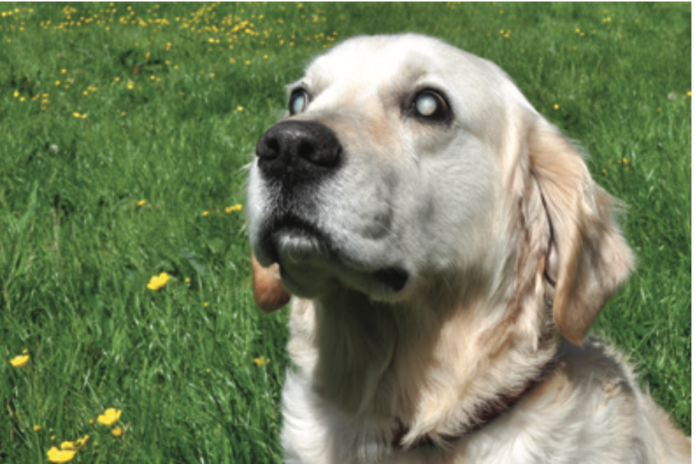As your dog ages, you may notice a bluish haze developing deep in his eyes, in the lenses, behind the pupils. You may start to wonder – does my dog have cataracts?
More than likely, if your dog is still able to see, this bluish haze is not a cataract, but a common, normal, aging change called lenticular sclerosis or nuclear sclerosis.
Healthy lenses are completely transparent, meaning perfectly clear, and all light that hits them passes easily through to the retina. With lenticular sclerosis, the lens fibers become compressed and somewhat degenerative over time, resulting in translucency. Translucent lenses are hazy or cloudy, allowing only partial passage of light. Lenticular sclerosis will not make dogs blind. They may not see fine details, but they will always see well enough to navigate without difficulty.
In contrast, cataracts are completely opaque. This means no light can pass through to the retina, resulting in blindness.
Cataracts can develop in young and old dogs alike. Causes include inheritance (dogs with cataracts should not be used for breeding), metabolic disturbances (such as diabetes), trauma, nutritional (orphan pups on milk replacer), and chronic uveitis (an inflammatory disease of vascular tissue deep in the eye).
In addition to vision loss, chronic cataracts can cause excruciatingly painful, unmanageable secondary issues within the eye, for which our only recourse is enucleation – surgical removal of the eye. This happens because the lens continuously degenerates over time, sparking chronic inflammatory changes around it. These secondary issues include lens-induced uveitis, glaucoma (increased intraocular pressures), and lens luxation (dislocation of the lens within the eye). Chronic cataracts can also cause retinal detachment, which frequently results in permanent blindness.
Is Cataract Surgery For Dogs Worth It?
Restoring eyesight and avoiding the above-mentioned problems secondary to chronic cataracts are the two main reasons to consider cataract surgery for your dog.
Are there reasons to not pursue cataract surgery? There sure are:
- General health of the dog. Is he a good candidate for general anesthesia? Not always. The risk of the procedure sometimes outweighs the benefit, especially in older dogs with heart or kidney issues. Does he have reasonable life expectancy after surgery? Depends on his age, and other things such as his cancer status.
- Condition of the eyes. Are the corneas healthy? This is important for a good surgical outcome and for vision. Are the retinas healthy? If they are not, the dog will still be blind, or will become blind, despite surgery.
- Ability of the dog owner to commit to post-surgical care. Post-operative care after cataract surgery is pretty intense, with multiple medications and topical preparations needing to be administered frequently around the clock. Sometimes lifestyles and/or work schedules can get in the way of this.
- Temperament of the dog. Let’s face it: Some dogs are difficult or even impossible to medicate/manage with such an intense post-operative protocol, both while in the hospital and at home afterward. This is unfortunately something that needs to be seriously considered.
What to Expect After Dog Cataract Surgery
Prior to surgery, your dog will have an electroretinogram (ERG) done to make sure that the retinas are healthy. It would be devastating to have a cataract removed to restore vision, only to find out your dog is permanently blind from retinal disease.
The surgery is called phacoemulsification. Small incisions are made in the cornea and the lens capsule. High frequency vibration is used to essentially pulverize the lens, which is then removed by vacuum. An artificial lens is inserted and the cornea is sutured closed.
After surgery, your dog will stay at the hospital for close post-operative monitoring for several days – longer if complications arise. The most common post-operative complications are protracted intraocular inflammation and glaucoma. Other complications include corneal ulcers, infection, and retinal detachment.
Once your dog is home, expect to be treating him with several eye drops four to six times daily and several oral medications. An Elizabethan collar so your dog can’t rub or scratch at his eyes and activity restriction are important aspects of the post-op plan. Follow-up examinations are performed frequently in the early post-operative period, and patients generally require at least one topical medication and routine examinations for the rest of their lives.
To avoid complications and ensure a good outcome, don’t wait once your dog has been diagnosed with cataracts. Cataracts mature with the passage of time. Post-operative complications are more likely from surgery on mature cataracts. Mature cataracts are also more likely to cause lens-induced intraocular inflammation, lens instability, and loss of lens capsule integrity, which are all things that may make your dog a poor candidate for cataract surgery. If surgery is performed, these complications may lead to a poorer prognosis for vision and comfort following surgery and may interfere with the successful placement of an artificial lens.
One Eye or Two?
If both eyes are affected with cataracts, whether to operate one or both depends on the stage of the cataracts and the overall health of the eyes. Because cataract surgery in dogs requires general anesthesia, if both eyes have cataracts and are candidates for surgery, both eyes are usually operated as one procedure. Some dogs may only have one eye that is a candidate for surgery despite bilateral cataracts.
If both your dog’s eyes are candidates for surgery, you may feel like well, maybe I’ll just have one done, since that would essentially restore vision, and obviously cost less than doing both. You can talk to your veterinary surgeon about this, but remember, untreated cataracts have the potential to cause worsening, painful damage inside the eye, which could end in enucleation. So there are more reasons to remove the cataract than just restoring vision.
Whenever possible, the best advice is to pursue surgical correction of cataracts, sooner than later. But if you or your dog are not good candidates for this, for the reasons described above, don’t lose hope. Talk to your veterinarian about instituting topical therapy with anti-inflammatory drops, to try to prevent cataract-associated ocular disease, and have your dog’s ocular pressures checked for glaucoma every four to six months.
Finally, do everything you can to make life as easy as possible for your blind companion. A resource worth checking out is Living With Blind Dogs: A Resource Book and Training Guide for the Owners of Blind and Low-Vision Dogs, by Caroline D. Levin.
Diabetic cataracts in dogs are caused by high blood sugar. Excess sugar (glucose) in the lens is converted to sorbitol, which draws water into the lens. This causes the lens to swell, resulting in disruption of lens fibers and oxidative stress, which ultimately results in cataract formation.
About 75–80% of diabetic dogs will develop cataracts within a year of their diagnosis, regardless of how well their diabetes is controlled. Diabetic cataracts tend to form quickly and frequently cause severe lens-induced uveitis, which in turn can result in glaucoma. Glaucoma is notoriously difficult to manage in these patients and many cases end in enucleation. The best bet for a diabetic dog with cataracts is prompt surgical correction.
There is not yet a way to prevent cataracts from forming in the eyes of diabetic dogs. But Kinostat, by Therapeutic Vision, Inc., is a promising new topical ophthalmic solution on the horizon, with provisional approval to go to market in the near future.
The conversion of glucose to sorbitol in the lens is mediated by an enzyme called aldose reductase. Kinostat uses an aldose reductase inhibitor to block the conversion of glucose to sorbitol in the lens, thereby preventing the damaging influx of water into the lens.
In a clinical trial, diabetic dogs treated with Kinostat were 85% less likely to form cataracts than diabetic dogs treated with placebo.







Reading this increases my regret over not getting a second opinion when my dog’s vet recommended against cataract surgery for my older Jack Russell many years ago. His advice wasn’t based on much besides ‘this surgery is much harder for dogs than humans, don’t put her through this’. Perhaps she wasn’t a good candidate for surgery, but I do wish I’d investigated more aggressively for her sake.
Informative but frightening article. Yet informative only as a one dimensional piece. This seems to be orthodox/allopathic discussion, plus no additional information regarding a substance mentioned called sorbitol. Perhaps a better discussion about the conversion from glucose to sorbitol is in order?
Also, what about some references to all the sorbitol we find in pet products, for example in pet toothpastes…should we be concerned with this? (as a fur family, we have decided to avoid this substance since it is not part of a healthy dog’s nutrition to begin with, and we recently found – far too late than we needed – products that seem to work as well as or better than the dog toothpaste most of which have needless, garbage ingredients in them….they are specially created veterinary essential oils by Animal EO, by the way.)
Back to the article….it would have been more helpful to have discussed dietary and supplemental prevention methods and then also a discussion of non allopathic methods of healing….instead of the usual suspects of drugs and surgery.
I hate comments like this. Oops – western medicine. Must be evil.
If you were truly interested in knowing about the process by which sugar is converted to sorbitol there is a wondrous tool called Google! You’ll learn all about the Polyol Pathway and the risk this poses for diabetic dogs – and people. Neither voodoo nor homeopathy is going to cure a dog’s cataracts. Sometimes surgery and actual pharmaceutical medications are needed.
We have a little dog that has a congenital cataract in his right eye. He was diagnosed at just four months of age. We had taken him in to our vet for a wellness check and she found it. Luckily, the cataract doesn’t appear to affect his vision very much and the veterinary ophthalmologist he sees (every three months) has said surgery isn’t needed at this point. We’re hoping at never will be. I had thought cataracts were just an “old age” thing, but some dogs can get them either unilaterally or bilaterally at quite a young age. Our poor little guy has had several serious health issues in his young life and had to have several surgeries before his first birthday. He was the runt of his litter and is about half the size of his siblings. But he’s got a huge personality crammed into his little body (all 8.6 pounds of it), he’s a real trooper, and we couldn’t love him any more than we do.
I had a blind dog. He was diagnosed at age 10 with a subluxated left lens and glaucoma in both eyes. I wasn’t given much hope for his eye disease in the beginning. He was started on several different eye drops at the University to bring down the pressures. I have to tell you that my blind boy defied every odd there was. He never had his eyes removed because I kept him on the medicine routine for 6 years. He was on the eye drops 4 times a day, as many as 6 different bottles. During the last year of his life he developed a corneal ulcer after a pressure spike. We decided to do a procedure to inject the eye ( which would shrink it) to remove the pressure. That is what caused the corneal ulcer. The ulcer eventually healed. I tell you all this because there IS hope and surgery is not always necessary. I made a decision that I would be my dog’s full time caretaker. He was adopted at 4 months old, went blind at age 10 and then last year he suddenly passed of liver failure and there was nothing I could do to save him. He truly was a rock star and I want to rescue another blind dog one day. My boy lived to be 15 years and 9 months, he was a beagle.
Hi, three of our small rescue dogs have had successful cataract surgery in both eyes. One was die to genetics, and two were due to diabetic changes. I regret that my Lucy wasn’t prescribed drops because we had to postpone due to winter storms 😢. We actually took out bank loans for this, and would do it again in a heartbeat. Our two current rescues are 5 and 2.5 years, and are being watched closely, especially the 5 year old…Anyone considering it for their furriend might at least have an appointment to discuss options… ❤️❤️❤️
My boy is now 10 years old, he was a stray, and for the past year his eyes had this bluish haze over them. Our vet was adamant that he can still see and that it was not yet time for a surgery. A few months ago during his routine yearly blood check we realized he had problems with his thyroid and he is since on medication for that. Lambros is a very patient little fellow but having pills shoved in his mouth twice a day started annoying him after the first month. So, I found a peanut butter that has no added sugar, salt or preservatives and put that on a biscuit as a sort of glue for the pill. Two weeks later his eyes started clearing. I don’t know if his “cataract” was thyroid-related or if it is a combination of the pills and the vitamins in the peanuts, but now his eyes are almost completely cured and there is hardly any cataract left.